The most commonly asked customer question I’ve encountered since working with houseplants is without a doubt ‘…what plants are best for a place that doesn’t get a lot of light?!’. And it’s a good question. A question that I have been sorely reminded of this winter in this black hole of a cottage, whilst frantically grouping my plants near to any light source — a window, a grow light, whatever works. I’ve piled a load of plants in front of the TV because there’s a few hours semi-decent south-eastern light there (if it’s remotely sunny) + my bedroom currently resembles a Ficus-themed assault course. So thinking about how to get my plants through the longest, darkest January prompted me to write this post, along with a friend that has just moved to somewhere on the gloomy side who has been asking for planting inspiration, given her light limitations.
The plants mentioned in this post are tried + tested low-light tolerant + have all lived with me in less than perfect conditions, so here are my picks, with some extra tips along the way + honourable mentions at the end. This post is also a good way to have a look at some houseplants in my collection that I might not share that often online too!
This topic warrants a longer form post as I wanted to be sure to provide enough detail about each plant, alongside plenty of photos too. It’s divided up into easy to navigate subheadings so you can dip in + out if you want. So get yourself a beverage of choice + I hope you enjoy some weekend houseplant reading!

A note on variegated plants
Before we get into the actual plants I would recommend, a quick note about variegation. Variegated plants are super popular online, but if your light levels are lacking, it’s better to opt for non-variegated varieties. Some variegations are quite forgiving, where as others will revert to solid green if the leaves don’t receive enough light — whether that’s in duration or intensity.
About the phrase ‘low light tolerant’
To get back to basics here for a minute, there are a few non-negotiable elements that plants need to grow — water, air, nutrients, a suitable temperature + of course light. So if you are thinking about what plants to put in your windowless bathroom or dark office you only visit occasionally, on a desk next to that heater, pause to consider whether plants are really the best choice in these instances. Thinking of plants as living, breathing things instead of simply a decor choice is important — they aren’t ornaments to last just a few months.
Saying that, there are some plants that do cope better than others in more shaded environments + I’ve detailed these here. But remember that to thrive + not just survive, plants will undoubtedly require decent amounts of light — hence the word tolerate. So take time to understand your environmental conditions + reserve brighter spots in your space for plant placement if you can. For example, I will always prioritise areas around windows + walls that get good natural light for my plants when designing a layout + reserve darker corners for things like bookshelves. To read more about taking a more considered, mindful approach to keeping houseplants, here’s a post I wrote a few months ago.


Switching locations…
This is a bit of advice that I don’t see mentioned all that often, but if you decide to move your plants to different areas of your home, or indeed, are moving to a new place with your plants like I did last year (3 part guide here on the process) — bear in mind that any drastic changes can shock your houseplants. Strong differences in light, temperature or humidity can send them into a strop + it can take a while for them to settle down. If you are just moving them around within extreme areas of your home then it’s a good idea to transition them so that they acclimatise gradually. You don’t want to be moving a plant from your dark shelf onto your south-facing windowsill without a transitional period of incrementally increasing the brightness. This can be giving it an hour of brighter light every day, or moving it somewhere slightly brighter for a few weeks before building up to a sunny spot. If you are new to houseplants, I know it might sound a bit ‘diva‘, but your plants will be happier + less likely to react adversely.
Ok, lets get into it…
1. Aspidistra elatior (Cast Iron Plant)




One of the most popular plants that seemingly thrive on neglect is an Aspidistra. It’s more commonly referred to as a ‘cast iron plant‘ because of its ability to cope with adverse situations with aplomb. The Victorians would often have an Aspidistra in rooms where almost all other houseplants wouldn’t survive in the polluted atmospheres of coal fires + gas lamps. If you’ve read houseplanthouse for a while, you’ll know my sentimental connection with this plant because my Aspidistra elatior is an heirloom plant for me — passed down as a division I made from my grandparents plant. For this reason, I am very attached to it + feel a certain pressure to keep it happy + healthy! I have a few other varieties, but the classic non-variegated Aspidistra has an unrivalled elegance in my opinion. I can certainly attest to it’s easy going personality + it’s ability to bounce back, even after forgetting to water it sometimes. These plants are slow growers so mature specimens can be expensive, but they’ve certainly increased in popularity in recent years, which might drive the price down in time. In a minimalist setting, these dark green leaves look understated but interestingly sculptural + they don’t take up much room either.
The photo below shows a wider view of where I grow two of my five Aspidistra plants — around 3 metres away from a South East window. They get an hour of morning light on a bright day, but otherwise it’s pretty dark here:

2. Epipremnum aureum (Golden Pothos / Devil’s Ivy)
A golden pothos is one of my absolute staples — so much so that I always have a couple of plants dotted around my place! They are the epitome of an easy going houseplant to me — they are forgiving if you forget to water them, they really don’t need a lot of light + they still grow relatively well in a less-than-perfect position. This is a definite bonus because some plants that are often classed as ‘low light houseplants’ can have a tendency to just sit there + not really grow at all if they are somewhere pretty dark! My smaller golden pothos lives 4 metres away from a small south east window in my bedroom + has still been putting out new leaves all the way through winter. One of my other larger Epipremnum has been hanging within one metre of a portable heater in my bedroom (not ideal) + has only got two or three yellow leaves as a result. The only compromise in a darker spot is that the beautiful golden variegation will revert more to a solid green hue, but these leaves are still cheerful + the thicker stems of mature specimens have a bounce to them as you can see in my photo below, which makes them a lovely trailing plant to have at home.


3. Aglaonema (Chinese Evergreen)
Aglaonema are one of those houseplants that some people find boring, but over the last year or so, I’ve noticed a definite buzz in popularity for these humble foliage plants, particularly online. This perhaps, has something to do with the huge variety of cultivars that have entered the market in the last couple of years. It’s worth noting that the trendy, pink + white varieties do require more light than the more classic green types, like I have below. These plants are really reliable to have around + fill out a corner or table top nicely. They are pretty slow growing, but I’ve had both of these quite a while + they have grown ok for me!
Side note: The windowsill photo is an homage to one of my favourite films Leon — there’s a blogpost here if you want to see the significance of the Aglaonema in this context!



4. Marimo



Probably the strangest plant I have here at HPH is my jar of marimo. Marimo are often called moss balls, but they are actually a type of algae that are rounded in form + fuzzy to the touch. They are often given as a symbol of love or friendship + can last hundreds of years, so make a lovely heirloom plant. They are very slow growing so can be displayed in an old jar or vessel like mine above. They don’t require lots of light so are a good choice for a coffee table or desk plant if you want something out of the ordinary. I always get comments on this plant from anyone that visits!
5. Zamioculcas zamiifolia (ZZ Plant)
ZZ plants are a low-light classic + can do well in ambient light conditions. The main point to remember with these is that lower light means less watering — especially with ZZ’s + their thick, succulent stems. I find it easiest to gauge watering needs with these by using a hygrometer, in conjunction with watering from a plate below. This winter, my regular ZZ suffered a bit of root rot with low light in combination with very cold temperatures, so this is something to note. Keep the deep, glossy leaves free from dust by giving your plant an occasional shower + it will be happy. They can grow (albeit slowly) to become quite a sculptural plant + for that reason, are a favourite of interior designers + architects.





6. Maranta
Marantaceae are a group that generally do well in partial shade, but Maranta is my recommendation out of the group that contains the more fussy Calathea, Ctenanthe + the slightly easier Stromanthe, for a low-light tolerant option. In my experience, Maranta can do well for many years in a shaded position, whereas some of the others are a bit more demanding or have a tendency to lose their variegation in dark rooms, like a Stromanthe triostar. I have a Maranta leuconeura var. kerchoveana, aka. ‘rabbit tracks’ which has the most amazing blue-green foilage, with dark brown splotches. The leaves fold + raise up at night, as if in prayer, which makes for an interesting show! The red-backed herringbone maranta (maranta leuconeura erythroneura) below centre is another popular choice, often seen in public building planting displays like malls, libraries + foyers. Maranta plants will actually look really washed out if they get too much sun, so a partially shaded area with soft light will keep them looking their best. Mine lives on top of the fridge around 2 metres from a north west window + has grown really well for me for the last few years.



7. Spathiphyllum (Peace Lily)
My Peace Lily definitely deserves some kind of award for being the most tolerant houseplant here at HPH. I will admit that I can’t even remember buying this plant — I’ve had it that long! Because of it’s happiness in a more shaded position, it lived on top of my fridge in my old apartment, around 3 metres from east facing french doors… it really was not very light in this position but amazingly grew from quite a small plant. In this cottage, it’s also in my kitchen + it lives 2 metres away from a draughty kitchen window of north-western exposure + here it gets soft ambient light throughout the day. This is a bit of a precarious spot though, because I keep my flour in the above cupboard which dusts my plant quite often… nothing an occasional shower won’t fix though! Despite not giving my Peace Lily that much attention, I do appreciate its low-light-coping capabilities. As my plant is maturing I’m enjoying how the beautiful texture of the foliage looks when it catches the light. A Spathiphyllum is super affordable + easy to get hold of, making it a great choice for leafy plant lovers.

8. Philodendron scandens (Heart Leaf Philodendron)
Even though a heart leaf philo might look a bit ‘basic’, it’s another one of those that I can’t really imagine not having in my plant gang. These hardy staples are a great starter plant if you are looking to build up your houseplant collection. Saying that, it took me a while to get one — I was besotted with my philodendron brasil for a long time before adding a scandens into the mix + once I’d brought it home, it fitted right in. Something I do love about these heart shaped leaves is how they look against a white background — a few stems in a pot feels really sweet hanging off a curtain pole or off a shelf. My main plant is 3 metres from a south east window + doesn’t need regular watering + is growing slowly but steadily. I’ve propagated some stems + these are in a shaded position + doing well. If you like a golden pothos, this is a nice alternative to consider.

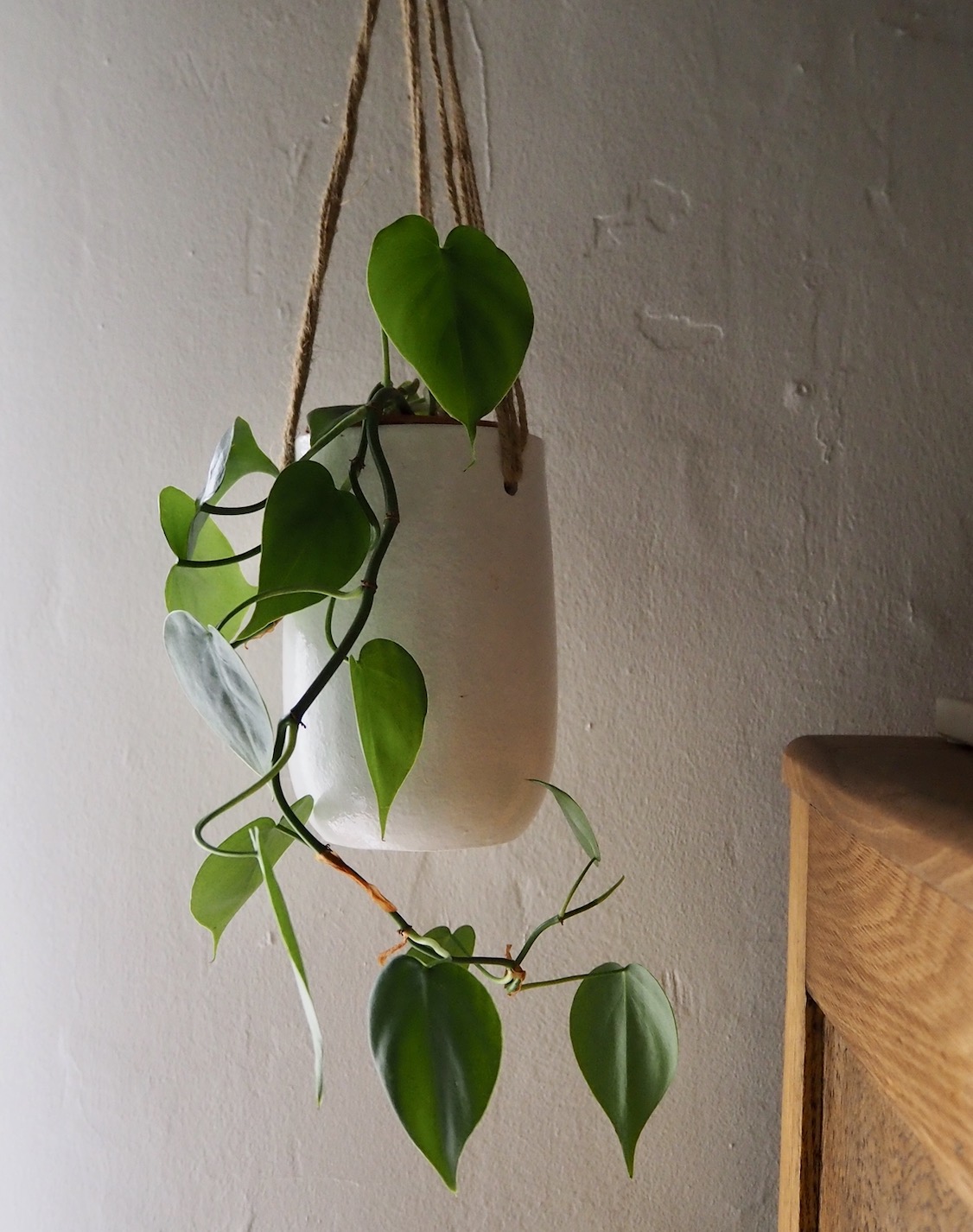
9. + 10. Chamaedorea elegans (Parlour Palm) / Howea forsteriana (Kentia Palm)
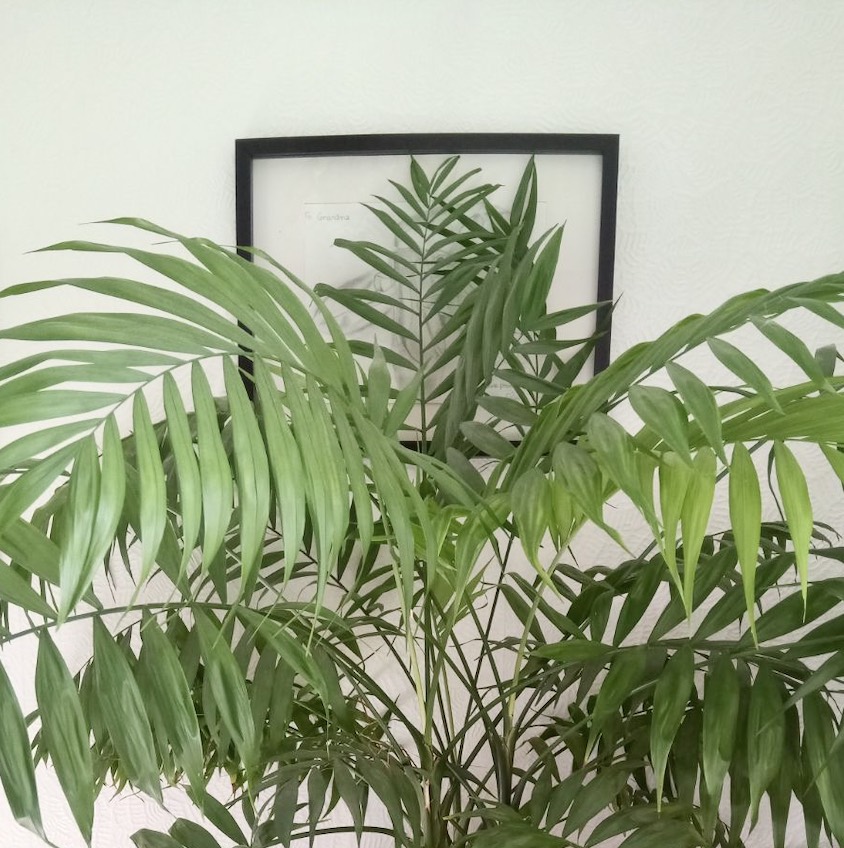

Ok, this might be cheating slightly because there are two plants mentioned under this point, but I’ve coupled them together because they are pretty visually similar + are sometimes mislabelled as the other one! But, one thing both of these palms have in common is that they are both particularly shade-tolerant varieties. As well as an aspidistra, a parlour palm was a classic Victorian houseplant, extremely forgiving to subdued light + polluted air from open fires. Above left is a stunning old Chamaedorea elegans belonging to a family member + above right is my tiny plant! Below is my Kentia palm — Howea foresteriana, which I have nurtured since a tiny plant of just two little stems. Here it was last Summer:


As a bit of reality, the photo below shows my plant after it got some frost damage this Winter…I accidentally left it on my doorstep overnight when I’d been doing some plant care one weekend! It suffered a bit from the cold snap but it’s in recovery at the moment + I’m looking out for new growth this Spring. These are two resilient, forgiving types if you like the look of a palm at home.

10. Syngonium podophyllum (Arrowhead Plant / Butterfly plant / Goose foot Plant)
I love a Syngonium + would like to add a few others into my houseplant family over the next few years — they are quite easy to have around + the green varieties, like my pixie lime below, tolerate a lower light setting really well. I grew my plant around 4 metres away from a west-facing window in my previous apartment, where it only got a hour of very late afternoon sun in the summer months. Here it has been happy around 3 metres away from a south-east position on my sideboard, where it gets a bit of sun in the morning, but not much else. If you are looking for something for a table-top that has interesting leaves, this would be a great choice.
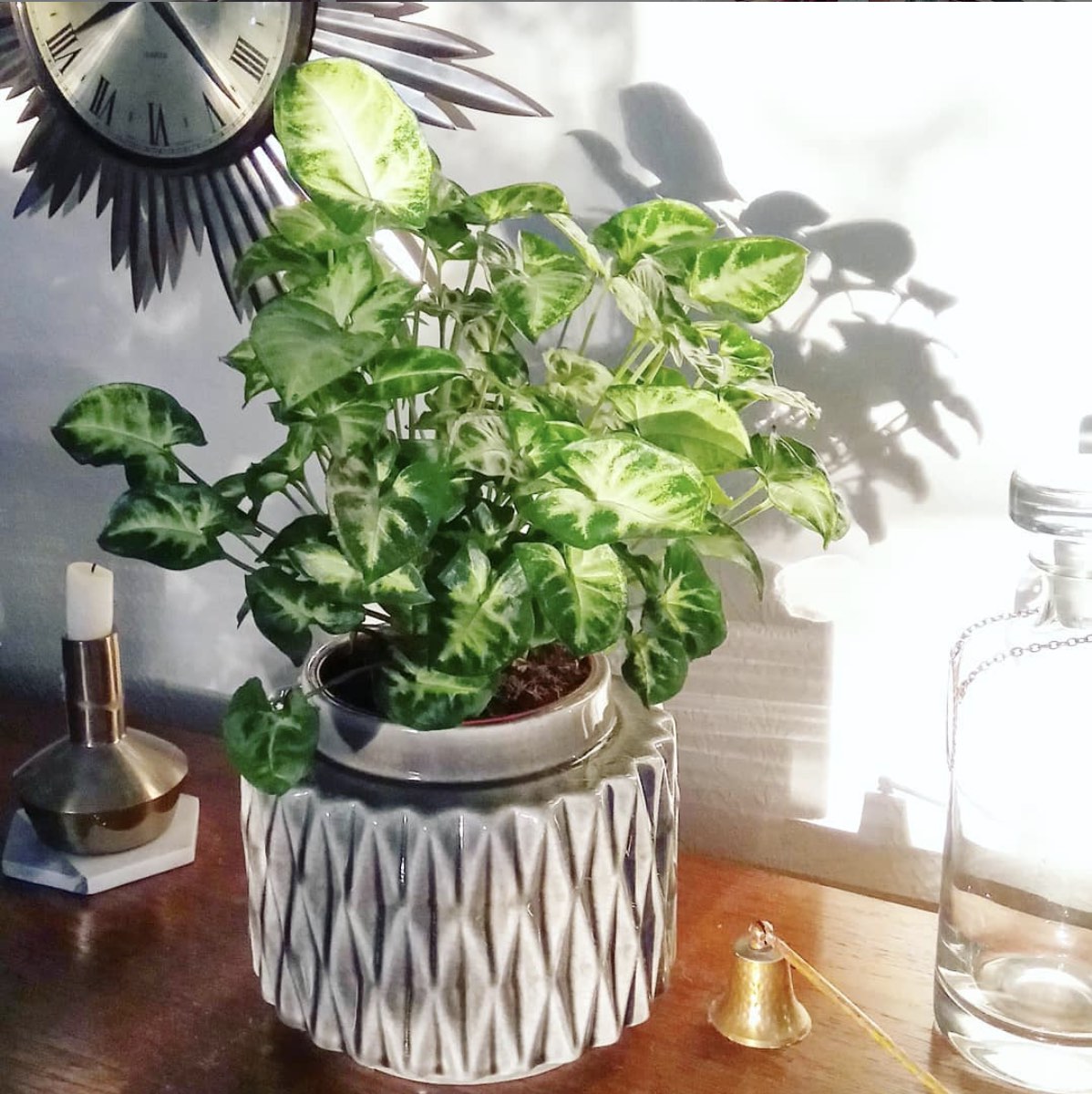

11. Dracaena marginata (Dragon Tree)
You can find a dracaena in almost any grocery store + the reason these plants are so popular is down to their easy care requirements — particularly that they don’t need watering too often – they do well in a position out of direct light, even somewhere with quite a soft light. I see them a lot used in bathroom design, where windows are often smaller than other rooms + one of my relatives has a really large one next to a bookcase in the back corner of her room for as long as I can remember. They might not be the most showy of plants buy their spiky shape is quite cheerful!



12. Vriesea + other Bromeliads
This one is a bit of a different + unusual plant to add to our list. If you are into Bromeliads, then a Vriesea splendens is a remarkable plant with the most incredible green leaves decorated with striking purple banding. This was the first bromeliad I bought + it proved to be a big hit with my customers too. Compared to other bromeliads, this one has a compact growth habit + a maximum height of around 0.5metres, making it great as a houseplant for small spaces. It’s also one of the most tolerant of lower light conditions than other plants in this family. After a few years, a spectacular red flower spike of red bracts can appear from the centre of the plant if it has been given warm enough temperatures. One of my customers experimented with growing it solely under fluorescent light + it did really well, though it won’t bloom in these conditions.


13. Chlorophytum comosum (Spider Plant)
It wouldn’t be a comprehensive low-light houseplants post without mentioning the classic Spider plant! These plants are notoriously adaptable to a range of light conditions + cope well with spells of neglect, dry-ish air, a warmer or cooler environment, a brighter location or a shaded spot too. This is why you’ll see these plants in a whole variety of places in the homes of those that grow them. They might not be as popular now as they were in the 70’s, but chlorophytum are a classic in my eyes + I have a sentimental attachment to them too. I grow three different cultivars in less than perfect conditions — certainly forgetting to water them now + again. Yet they are all still growing well + producing plantlets! I got my hands on a non variegated Spider plant (Chlorophytum ‘Lemon’) a few years ago, which has been a nice alternative to these characteristically stripy leaves if you like this plant but fancy an alternative choice.
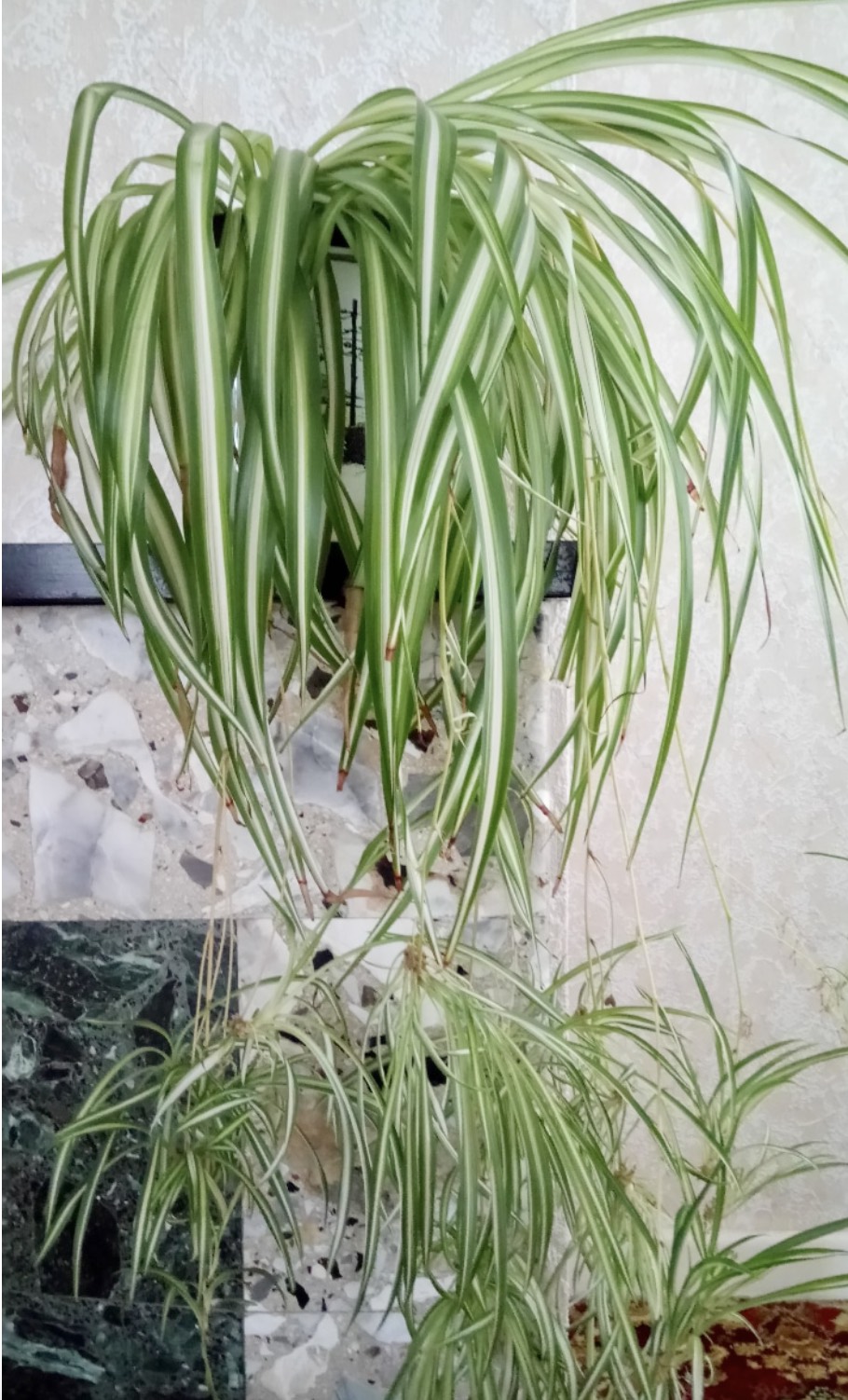

14. Schlumbergera (Christmas/Easter/Thanksgiving Cactus)
These are another ‘old school’ type of houseplant that is loved by many because it is often one of those plants that people remember grown at home by their parents / grandparents. My plant in bloom is below left + the plant in the centre + to the right are my mum’s plants. They have been growing in a shaded position on top of her cabinet for many, many years. Despite not getting much light at all, they flower every year without fail! If you like other Jungle cacti such as Rhipsalis, a classic Schlumbergera is an understated (+ often underrated) plant with similar credentials + is often a much more affordable option too!



15. Dracaena trifasciata (Sansevieria Snake Plant)


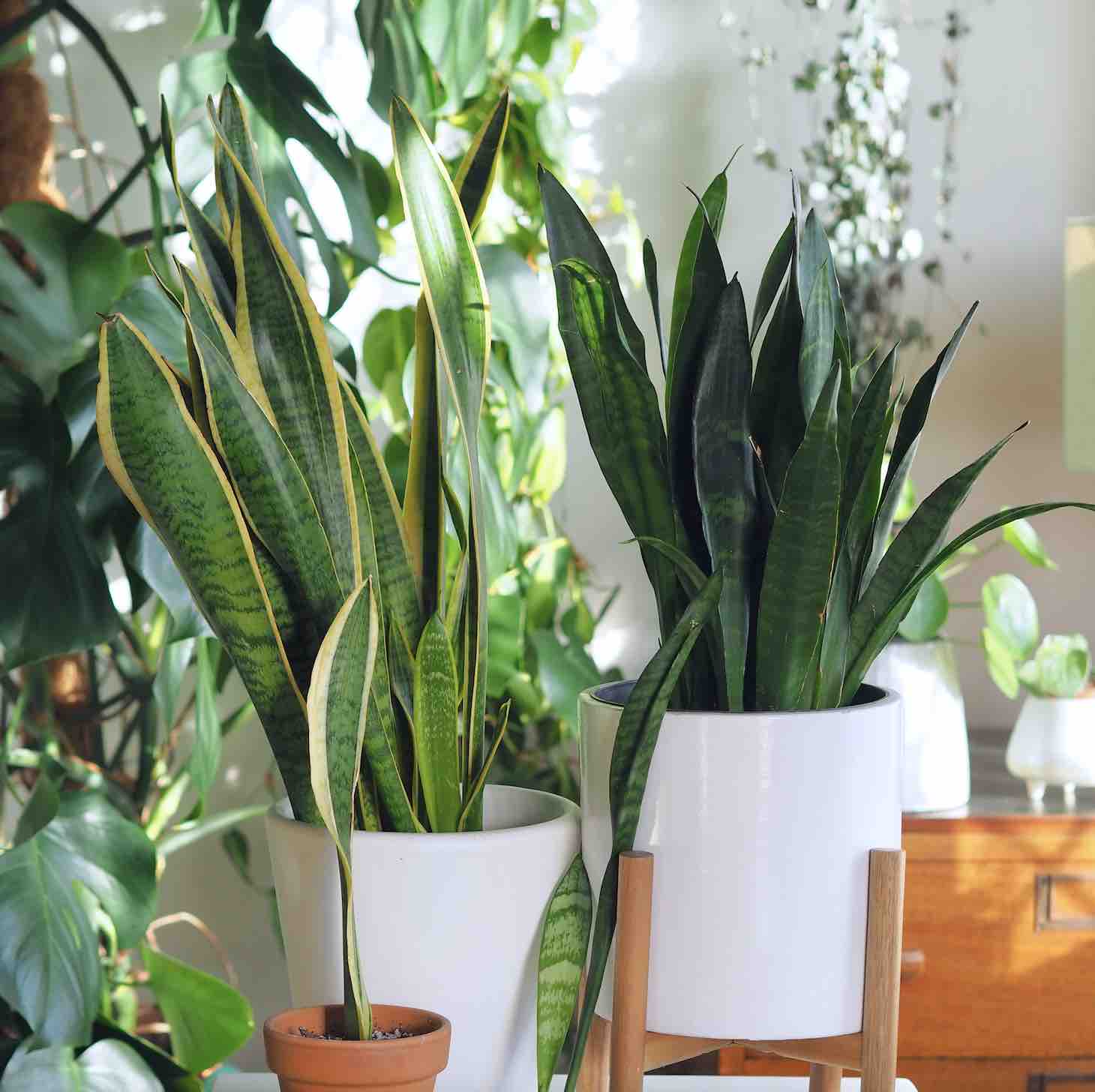
Snake plants are one of the most commonly advertised ‘low light houseplants’, yet I must say here, I don’t really choose to grow my own plants in this way. For the lower light locations at home, I will choose some of the other plants in this list over a Dracaena/Sansevieria trifasciata. Saying that, I did want to include it towards the end of the list because it’s true, they do put up with shade. But these plants are a classic example of what I meant earlier in the post by unpicking the phrase low light tolerant a bit, because snake plants really grow so much better in a brighter location that it feels a shame to subject them to lots of shade. They always look a bit sad to me in a dark corner with spindly leaves! I’ve chatted to a few of you about this too + have had quite a few questions about why your snake plants aren’t growing… + more often than not, it’s because plants are in a location that is too dark because the care label said they are for low light. So if you can, I’d reserve these plants for somewhere that gets a decent amount of light if possible.
Some honourable ‘group’ mentions… —
I wanted to include some honorable mentions of groups of houseplants that have been low-light tolerant for me, that I think you might also consider…
Begonias
I’ve got a few begonias + I’ve been pleasantly surprised with how well they have done in quite a soft light. They do get a bit leggy, but nothing a chop + prop won’t fix. Of all my plants, I’ve been really enjoying how my Begonia maculata wightii has been growing next to my Peace Lily in the kitchen. It’s next to my hob + occasionally gets knocked with the salt or pepper grinder that lives next to it, but it’s been very forgiving. I couldn’t believe my eyes a few weeks ago, when I noticed the tiniest leaf was peeping up out of the potting mix!


As a bit of a plant progress, here’s a month between the photos above (Jan 2021) + below (Dec 2020). My begonias have not stopped growing over Winter like some of my plants + they have coped incredibly well in my kitchen that got down to about 8-9°C.

Ferns
It would be wrong not to mention ferns in this post, but I wanted to include them as a more general category instead of listing all the different varieties I have in my collection. Some ferns like asplenium nidus / Birds nest fern is pretty adaptable + looks more dynamic when given a brighter, indirect light position. This creates more pronounced ‘crinkles’ or waves on the leaves/fronds, whereas growth is flatter in a darker position, but still lovely! Adiantum / Maidenhair ferns are much less likely to crisp up if the light is softer + indirect in nature, but if it is too dark, the plant could start to yellow. I have grown mine a few metres away from a north-west window, or closer to an east or north window is also an ideal location.
I do also love an Asparagus densiflorus sprengeri, aka Asparagus or Emerald Fern. But it’s worth knowing that this plant is not actually a true fern + is part of the Lily family! My plants have been growing in quite a dark location, trailing off the top of a shelf for the last year with only indirect light + when I moved them to take a photo this week, I couldn’t believe how much they had grown!












Dieffenbachia
Finally, the Dieffenbachia group is another to consider if you like large, leafy plants like Ficus elastica, but don’t really have a lot of bright light in your space. There are some amazing cultivars like my Dieffenbachia ‘reflector’ here, below right — which grew happily in a position 4 metres away from my south-west windows. They are quite slow growers in ambient light conditions, but I find the leaves so mesmerising, I don’t mind if they take a while to appear!


* Ways to add light to your space — or making most of the light you have!


One of my most used plant styling hacks for bringing light into a space + making the most of the light you have is with the use of mirrors. Mirrors can be such a game changer in smaller apartments or homes that lack the luxury of square footage for two reasons. They create depth in a space, making it feel larger in scale, but by cleverly positioning mirrors adjacent to windows, they bounce more natural light in. This adds extra illumination for your houseplants + provides a more rounded, less directional light. Furthermore, displaying your houseplants close by will have a doubling effect — the reflections creating the illusion of a lush, viridescent view.
An alternative + easy way to add in supplementary light is by using grow lights, particularly during winter months, where plants can struggle. I’ve put a whole post together about this if you want to have a read (here!).
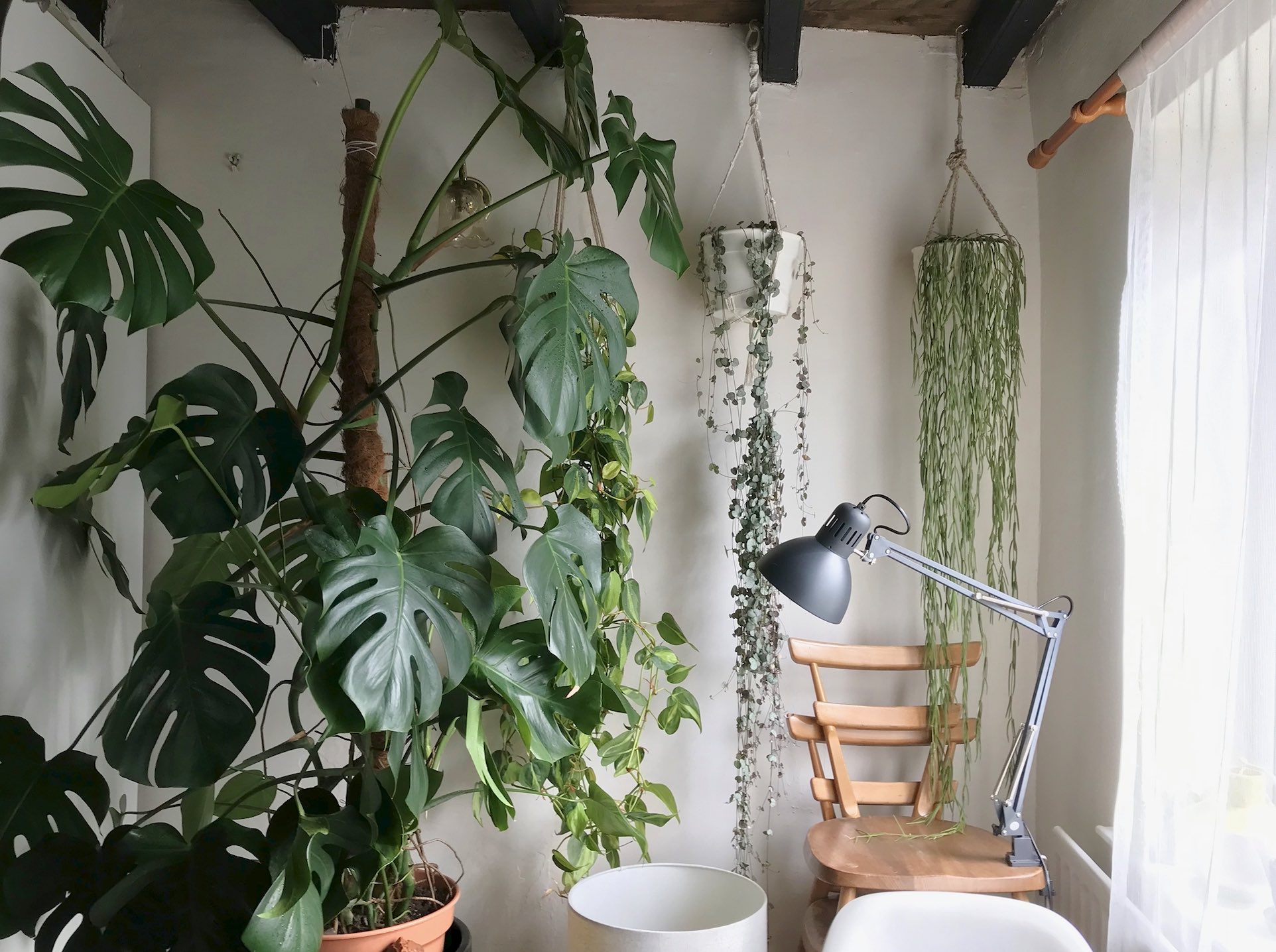

An extra point on watering + humidity …
In a darker location, growth will undoubtedly be slower, so don’t make the mistake of thinking watering your plants in these areas more will pep them up — this is a very common error! Low light tolerant houseplants need less water (sometimes much less) so be mindful of this before habitually picking up your watering can! If you struggle with getting houseplant watering right, I’d really recommend getting a hygrometer to check the moisture of your pots to ensure you aren’t overwatering, here’s the one I use. I’ve had mine for a quite a few years, but I’m noticing that these have become more widely available recently. Even though I think I understand my plants pretty well now (some have been hanging around here for quite a few years!) I’ll still regularly reach for my hygrometer to check — it’s taken a while to understand the light + temperature situation in this temporary cottage + it’s been great for that! As an example, I can easily go a whole month between watering some of my plants in the darker areas here, because the temperatures are also low + the humidity is very high. It’s good to remember that these things go hand in hand + light, humidity + watering needs are intrinsically connected so don’t think of them as separate aspects in isolation.


Conclusion
So there we have it, some houseplant ideas for lower-light conditions! As a final tip I want to add in conclusion… next time you are visiting a botanical garden, or nursery, or even if you are lucky enough to find yourself surrounded by plants in their native habitats… pay extra attention to the darker locations you might miss whilst craning your neck at the more showy, statuesque plants!
I have been known to walk around a botanical glasshouse twice to take in the plants at all levels, or to take time to find a bench to sit + observe what you might miss at first glance at ground level! The planting in these areas is a great source of further inspiration for the darker locations in your home. Notice any ones that catch your eye + take photos / make a note + keep a look out for them next time you are plant shopping. This photo of Adiantum (maidenhair ferns) growing beautifully was taken in a shaded area alongside a concrete path on my last visit to the Royal Botanic Gardens Edinburgh —

I’ve been working on this post for a while as it’s a longer read + it took some time to collate my photos together, so I really hope you enjoyed it. Please feel free to share with someone who loves houseplants but might not have those enviable south-facing windows! I will also be posting some more on this topic over on my instagram + here are some pins to save/share too:
*Affiliate links are used in the post which means I can receive a (very) small amount of commission if you make a purchase — thank you for supporting my blog. I often get asked where I get specific items from so have linked these here. I have bought all these products with my own money.


Leave a Reply